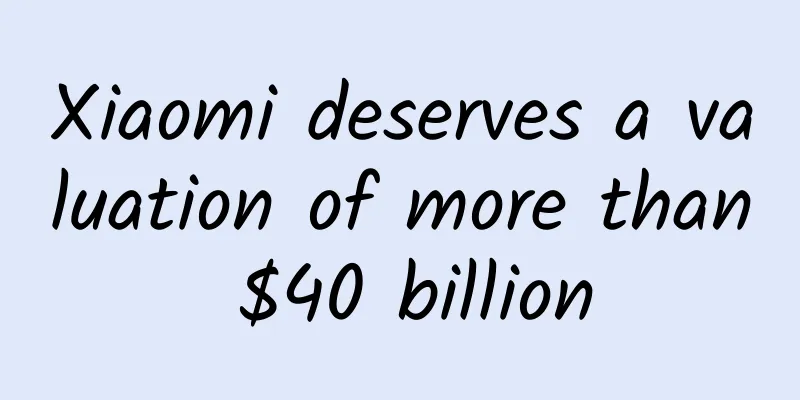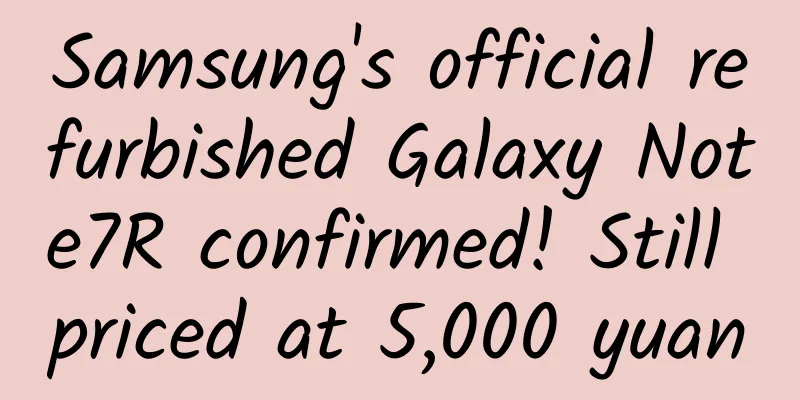Xiaomi deserves a valuation of more than $40 billion

|
Xiaomi recently completed its fifth round of financing, and the company's valuation jumped to the level of US$40 billion. According to reports, this round of Xiaomi's financing was led by Singapore investment company GIC, and followed by many domestic and foreign institutions. In August 2013, Xiaomi completed its fourth round of financing with a valuation of US$10 billion, and the amount of financing was unknown; in June 2012, Xiaomi completed its third round of financing of US$216 million, and its valuation at the time was US$4 billion; at the end of 2011, Xiaomi completed its second round of financing of US$90 million, with a valuation of US$1 billion; at the end of 2010, Xiaomi completed its first round of financing of US$41 million, with a valuation of US$250 million. After five rounds of financing, Xiaomi's valuation has soared from US$250 million to more than US$40 billion, a 160-fold increase in four years. This is nothing short of a miracle. Of course, each round of investors did not give Xiaomi sky-high valuations. As long as they are investment institutions, I believe they will evaluate the value of Xiaomi according to the most common price-to-earnings ratio method. In early November this year, when Xiaomi was raising bank loans, the Wall Street Journal disclosed that Xiaomi's revenue in 2013 was 27 billion yuan and its net profit was 566 million US dollars (about 3.46 billion yuan). If the valuation is 10 billion US dollars, the investment institutions give Xiaomi a PE of about 18 times. For the fast-growing Xiaomi, this valuation is not high. Alibaba, which recently went public, is probably the company with the highest P/E ratio in China, currently at about 55.6 times. Institutions estimate Alibaba's 2016 valuation to be between 40 and 45 times PE. If the valuation of Xiaomi is calculated based on the same P/E ratio, then a valuation of more than 40 billion US dollars is also reasonable. With a valuation of more than 40 billion US dollars and a P/E ratio of 40 times, Xiaomi's annual net profit this year is about 1 billion US dollars. It seems that Xiaomi will have no problem achieving this net profit target. Lei Jun, CEO of Xiaomi, once revealed the following information: the company's sales including tax in 2013 was 31.6 billion yuan, a year-on-year increase of 150%, and 18.7 million mobile phones were sold. According to Lei Jun's plan, Xiaomi's sales will reach 70 billion yuan and mobile phone sales will reach 60 million units in 2014. In the first half of this year, the company achieved sales of 33 billion yuan and mobile phone sales of 26.11 million units. If Lei Jun's plan is completed, revenue doubles and mobile phone sales increase threefold, then we have reason to believe that Xiaomi's profits will also increase by about 100%. Recently, Xiaomi Technology invested in Midea Group, revealing that Xiaomi Technology's net profit in 2013 was less than RMB 400 million. This is very different from the data reported by the Wall Street Journal (about RMB 3.46 billion). This is actually not surprising. Xiaomi Technology should be an entity operating company that Xiaomi uses the VIE structure to control its interests, but through a series of related transactions, Xiaomi should have transferred most of its profits to overseas markets with low tax rates to reasonably avoid taxes. Starting from MIUI, to Xiaomi mobile phones, to Xiaomi boxes, Xiaomi routers, Xiaomi TVs, and to today's Xiaomi air purifiers, Xiaomi is building a huge ecosystem around mobile phones. If this plan succeeds in China and can be continuously replicated in overseas markets, I believe that the valuation of more than 40 billion US dollars still greatly underestimates the value of Xiaomi. As a winner of Toutiao's Qingyun Plan and Baijiahao's Bai+ Plan, the 2019 Baidu Digital Author of the Year, the Baijiahao's Most Popular Author in the Technology Field, the 2019 Sogou Technology and Culture Author, and the 2021 Baijiahao Quarterly Influential Creator, he has won many awards, including the 2013 Sohu Best Industry Media Person, the 2015 China New Media Entrepreneurship Competition Beijing Third Place, the 2015 Guangmang Experience Award, the 2015 China New Media Entrepreneurship Competition Finals Third Place, and the 2018 Baidu Dynamic Annual Powerful Celebrity. |
<<: The big screen is not the goal but a means. Where is the smart car heading?
>>: Yu Yongfu: Why did AutoNavi seek cooperation with Guo Degang?
Recommend
Things about naming asteroids: Stars that cost money are not good stars
Produced by: Science Popularization China Produce...
16 creative ideas and keyword intent analysis for medical bidding promotion!
We know that each keyword has its own part of spe...
A guide to continuous traffic monetization in online education!
As an observer of the education and training indu...
Cadillac CT6 debuts at Guangzhou Auto Show: Presidential-level car also has hybrid version
Although America and Europe are both the most mat...
The North American Auto Show released a preview of the new generation Lexus LS
Recently, Lexus officially released a preview ima...
How many of these Weibo promotion techniques have you used?
What are the methods of Internet marketing? You c...
How does double-click wake-up work on smartphones?
There are many ways to wake up the screen, and th...
Take the example of collecting five blessings: How to plan a super marketing campaign?
What is super marketing? [Super Marketing] is the...
Can you get syphilis by swimming in a public swimming pool? The truth is...
During the long holidays, many people will arrang...
One article to understand Toutiao advertising placement
" Toutiao " is a personalized recommend...
Tips on how to get an operational plan with millions of PVs!
There are two types of information platforms on t...
How to start community operation and fission planning from scratch?
In order to seek breakthroughs under the epidemic...
Zuckerberg becomes world's ninth richest person as stock prices rise
[[141857]] According to CNN, the social media gia...
Tesla chairman talks about Musk: I don't think he faces any challenges
Last fall, the Securities and Exchange Commission...
Bypass: The ticket grabbing software with the highest success rate in 2020
1. What is the account used for logging in? The a...









